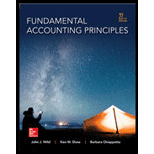
a
Introduction: Each company is required to adopt a method for valuing its inventory. There are several methods available for
To calculate: Costs assigned to units sold.
b
Introduction: Each company is required to adopt a method for valuing its inventory. There are several methods available for valuation of its inventory by a business. Some of them are FIFO, LIFO, Weighted Average and Specific Identification method. Each of these methods has its own pros and cons which are required to be considered while deciding the method to be adopted. The method adopted while solving is problem is FIFO.
To calculate: Costs assigned to ending inventory.
c
Introduction: Each company is required to adopt a method for valuing its inventory. There are several methods available for valuation of its inventory by a business. Some of them are FIFO, LIFO, Weighted Average and Specific Identification method. Each of these methods has its own pros and cons which are required to be considered while deciding the method to be adopted. The method adopted while solving is problem is FIFO.
To state: How likely will this method reflect actual flow of goods
d.
Introduction: Each company is required to adopt a method for valuing its inventory. There are several methods available for valuation of its inventory by a business. Some of them are FIFO, LIFO, Weighted Average and Specific Identification method. Each of these methods has its own pros and cons which are required to be considered while deciding the method to be adopted. The method adopted while solving is problem is FIFO.
To state: The impact of FIFO method versus other methods for net income and income taxes
e.
Introduction: Each company is required to adopt a method for valuing its inventory. There are several methods available for valuation of its inventory by a business. Some of them are FIFO, LIFO, Weighted Average and Specific Identification method. Each of these methods has its own pros and cons which are required to be considered while deciding the method to be adopted. The method adopted while solving is problem is FIFO.
To state: How closely does the ending inventory amount reflect replacement cost
Want to see the full answer?
Check out a sample textbook solution
Chapter 6 Solutions
Fundamental Accounting Principles -Hardcover
- The cash purchase price in a stock acquisition is $1,450,000; the book value of the acquired company is $950,000. The book values of equipment, land, and patents need to be adjusted (-$40,000), (-$65,000), and $190,000, respectively. Goodwill, if any, is recorded at_. a. $0 b. $415,000 c. $85,000 d. $195,000arrow_forwardPlease solve this question General accounting and step by step explanationarrow_forwardCould you explain the steps for solving this General accounting question accurately?arrow_forward
- I am searching for the correct answer to this general accounting problem with proper accounting rules.arrow_forwardI am looking for the correct answer to this general accounting problem using valid accounting standards.arrow_forwardHello Tutor Provide Solution Without Fail About this Questionarrow_forward

 AccountingAccountingISBN:9781337272094Author:WARREN, Carl S., Reeve, James M., Duchac, Jonathan E.Publisher:Cengage Learning,
AccountingAccountingISBN:9781337272094Author:WARREN, Carl S., Reeve, James M., Duchac, Jonathan E.Publisher:Cengage Learning, Accounting Information SystemsAccountingISBN:9781337619202Author:Hall, James A.Publisher:Cengage Learning,
Accounting Information SystemsAccountingISBN:9781337619202Author:Hall, James A.Publisher:Cengage Learning, Horngren's Cost Accounting: A Managerial Emphasis...AccountingISBN:9780134475585Author:Srikant M. Datar, Madhav V. RajanPublisher:PEARSON
Horngren's Cost Accounting: A Managerial Emphasis...AccountingISBN:9780134475585Author:Srikant M. Datar, Madhav V. RajanPublisher:PEARSON Intermediate AccountingAccountingISBN:9781259722660Author:J. David Spiceland, Mark W. Nelson, Wayne M ThomasPublisher:McGraw-Hill Education
Intermediate AccountingAccountingISBN:9781259722660Author:J. David Spiceland, Mark W. Nelson, Wayne M ThomasPublisher:McGraw-Hill Education Financial and Managerial AccountingAccountingISBN:9781259726705Author:John J Wild, Ken W. Shaw, Barbara Chiappetta Fundamental Accounting PrinciplesPublisher:McGraw-Hill Education
Financial and Managerial AccountingAccountingISBN:9781259726705Author:John J Wild, Ken W. Shaw, Barbara Chiappetta Fundamental Accounting PrinciplesPublisher:McGraw-Hill Education





